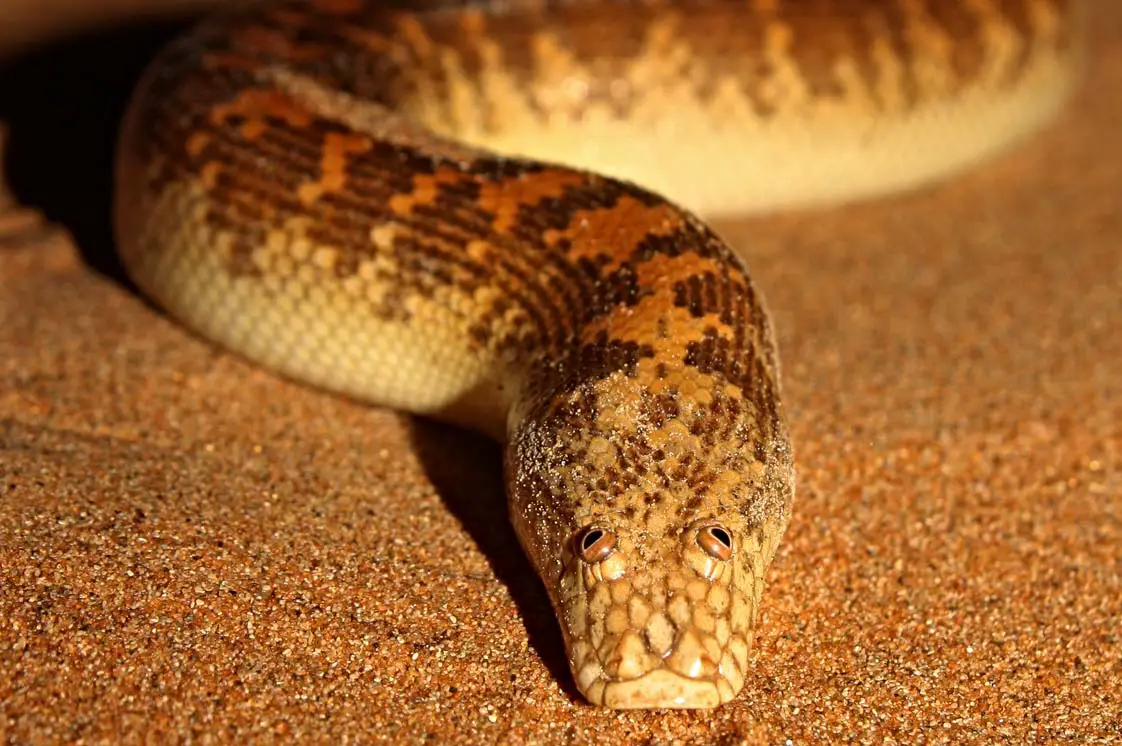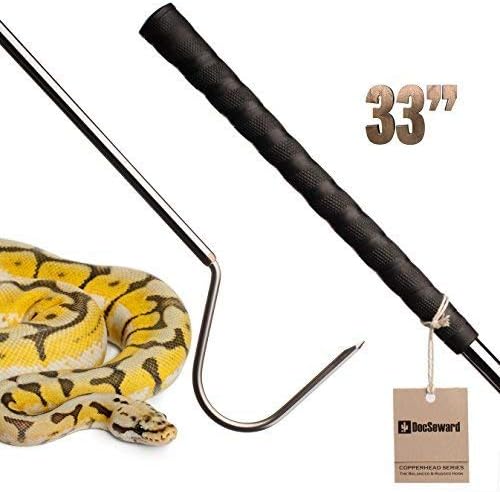The Arabian Sand Boa (Eryx jayakari) is a wonderful pet snake to have as they are hardy creatures and are easily handled. Like all boas they are not venomous; instead, they are ambush hunters and will use their bodies to constrict their prey.
These boas are perfectly adapted to living under the sand as their eyes are on top of their heads. This means that their bodies can remain under the sand while they keep an eye out for prey.
They have a pretty basic setup in terms of enclosure and feeding regime which makes them pets great for beginners.
| Common Name: | Arabian Sand Boa |
| Scientific Name: | Eryx jayakari |
| Natural Habitat: | Deserts in Saudi Arabia, Oman, Iran, Iraq, UAE |
| Adult Size: | Approximately 16 inches |
| Lifespan: | 20 years |
| Diet: | Lizards and mice |
| Experience Level: | Beginner |
| Enclosure Size: | 20 inches long X 10 inches wide X 10 inches high |
Reptile Overview
The Arabian Sand Boa is adapted to desert life and burrows under the sand to thermoregulate itself. They are typically nocturnal snakes, coming up to the surface layer of sand to hunt and thermoregulate.
They are listed as Least Concern by the ICUN and do not have any restrictions placed on them. However, they are easily kept and bred in captivity so we discourage the practice of purchasing wild-caught species.
These boas are good eaters and should not give new owners any problems. They are not livebearers as most of the boa family are. They lay a clutch of 5 to 15 eggs which hatch in approximately 66 days.
These snakes are pretty calm and do well with careful handling. However, they can strike out if they are feeling grumpy or think your fingers look like a good meal.
Appearance
The Arabian Sand Boa is a small snake only getting to about 16 inches in length.
This species is quite sexually dimorphic which makes sexing them fairly easy. The male is significantly smaller than the female when they are fully grown.
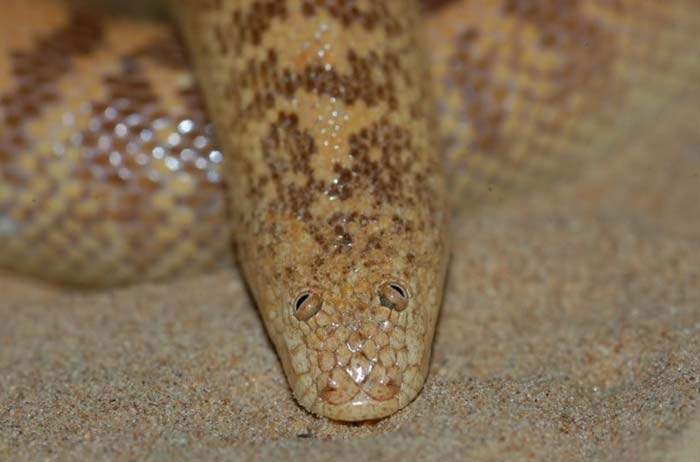
From juveniles, the female’s tail is very short and blunt, there is no clear distinction between her tail and body. The male’s tail is clearly distinct. It narrows significantly after his vent and is much thinner and longer in comparison to the female’s tail.
These snakes come in varying shades of brown to tan. Their coloring follows a staggered transverse pattern of light and dark. This coloration helps them blend into their natural surroundings in the desert on the Arabian Peninsula.
Their heads are not distinct from their bodies as most boas are. This gives them a distinctly noodle-type look. Their eyes are on top of their heads. Basically, the snake looks like a child drew it because of its comical googly-eyed appearance.
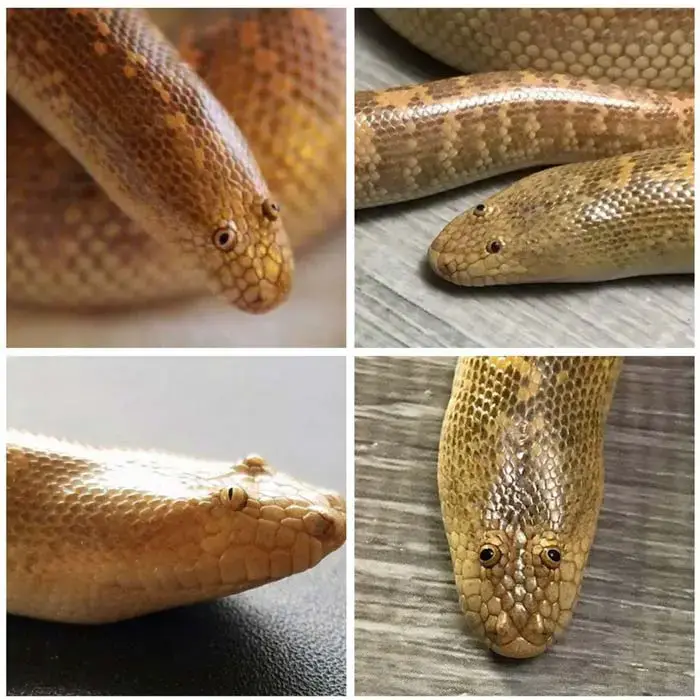
However, their appearance makes them highly adapted to their natural environment as burrowers in the desert sand.
Temperament
These are naturally calm snakes. However, they will strike out if they feel threatened.
Due to their body shape and ambush-hunter nature, they normally strike out sideways instead of straight on. This can cause new owners to be nervous as they do not display any distinct aggressive behavior before they strike.
Behavior
Arabian Sand Boas are nocturnal creatures. This means they are most active at night. They are typical ambush predators. However, some will actively go hunting at night and eat diurnal (active during the day) prey that is resting.
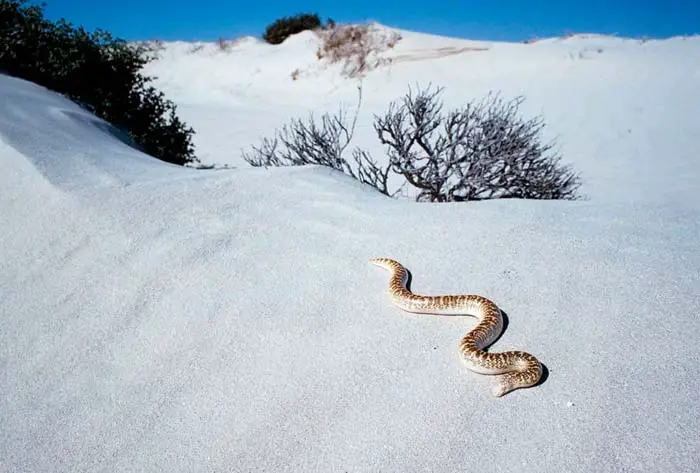
These boas burrow under the sand. They do this to thermoregulate. This means they cannot control their own body temperatures as mammals do. So, they go to areas that are warmer or cooler to help their metabolic processes.
They should be able to maneuver in their enclosure as they would in the wild which means they need a deep substrate.
These boas can be quite shy and nervous so they will attempt to get away from you by burrowing in their substrate.
Lifespan
The average lifespan of the Arabian Sand Boa is 20 years.
Enclosure
The enclosure needs of this Sand Boa are minimal and easy to upkeep which is why it is on our Beginners List.
We recommend an enclosure that is slightly longer than your snake. If your adult Arabian Sand Boa is 16 inches long, then we suggest a tank that is 20 inches long X 10 inches wide X 10 inches high.
We suggest an enclosure that is made of glass or plastic. Wooden enclosures are also fine to use. However, if they get wet they need to be dried completely to avoid boosting the humidity to fatal levels.
The enclosure needs to have good ventilation that does not affect the temperature gradient. Stagnant air is very bad for a snake’s respiratory health. You can achieve this by having a screen top or installing small computer fans to circulate the air.
You can add some foliage to the enclosure to make it more aesthetically pleasing. It can be natural foliage as long as it does not interfere with the humidity level and is not dangerous to your snake. You can also use fake foliage, we recommend silk plants.
We always suggest a good lockable lid or door for any boa enclosure. They are strong snakes and can push doors and lids open and escape into your house. We recommend a sliding lid that latches securely.
If your Arabian Sand Boa escapes, it could be fatal because your house does not follow its habitat needs and there are things that can hurt it like cats, dogs, and parrots.
You must clean the enclosure once every 2 – 3 months. Remove the snake and do a full sanitization of the enclosure, hideaways, enrichment materials, etc.
You can clean natural wood by boiling it in water and letting it dry completely before putting it back into the enclosure.
Substrate
Although it is called an Arabian Sand Boa and comes from the desert, we do not recommend that you keep your boa on a sand-based substrate.
If you use sand, there is a high chance that your snake will ingest it during feeding and this can cause an impacted digestive tract which can be fatal.
Additionally, if the sand gets wet it can clump together and fill your snake’s mouth. If the sand gets wet it will also increase the humidity levels dangerously.
We suggest using paper towels, butcher’s paper, or newspaper as the cheapest and easiest to clean option.
Put a couple of layers down on the bottom of the enclosure, then scrunch some up to create a layer of substrate for your snake to burrow under. You can also use aspen wood chips for a more natural look.
We recommend to use natural aspen bedding from Galapagos. It’s great for Arabian Sand Boas any other burying snakes like Kenyan Sand boa.
Galapagos Aspen Digs Shavings Bedding
The substrate needs to be deep enough for your snake to burrow in. It must be at least 2 inches deep.
Never use pine or cedar. They are toxic to snakes. They cause skin irritation and respiratory problems.
You should spot clean your substrate daily and replace it with new substrate every week if using paper towels, newspaper, or butcher’s paper. If you are using woodchips, replace the substrate once a month.
Regardless of what substrate you use, we suggest using some nice flat rocks that won’t roll over to line parts of the bottom of the enclosure.
You can add a branch or big rock for your snake to perch on and climb. Enriching your reptile’s environment is always a good idea.
Temperature
Reptiles need to thermoregulate their bodies by moving to areas that are warmer or cooler. You need to provide a suitable temperature gradient so that your Arabian Sand Boa can thermoregulate.
You do this by having a warm side and a cool side of the enclosure.
You create a warm side by using an under-tank heating pad. This needs to be controlled by a thermostat. For this reason we are using VIVOSUN Reptile Heating Pad with digital thermostat.
We suggest that you have a little hideaway on the warm side of the tank that your snake can curl up in if it is feeling stressed.
VIVOSUN Reptile Heating Pad with Digital Thermostat
The cool side of the tank does not need a heating or cooling element. It just needs to be far enough away that the temperature drop stays constant.
- Cool Side: 75°F
- Warm Side: 85°F
You need to have a basking spot at the hottest point of your enclosure. You need to install a heat lamp or ceramic heat emitter.
Whichever one you use must be enclosed in a protective dome or your snake will burn itself.
- Basking Area: 90°F
Set up your enclosure and get the temperature gradient right BEFORE you bring your pet home. If you fiddle around with the gradient and try to get it right while your snake is trying to adjust, it may die due to stress and lack of appropriate thermoregulation.
Lighting
Your Arabian Sand Boa does not need special lighting. However, UVB lighting does have added health benefits.
Arabian Sand Boas are nocturnal animals and require a 12/12 light/dark schedule. We suggest you use a timer like Zilla Digital Timer to avoid any mishaps, snakes cannot bark or meow if their light has not been turned on or off.
If the enclosure is in a room that receives natural sunlight, make sure it does not fall directly onto the enclosure as the added heat can increase the temperature to fatal levels.
If you wish to view your snake at night, we suggest using an infrared light that does not impact the temperature gradient.
Humidity
Arabian Sand Boas come from a pretty dry and arid habitat therefore their enclosure’s humidity levels should mimic this.
The humidity level should be around 40%. Use a hygrometer to keep accurate track of this level. It is key to maintaining your boa’s health.
If the humidity is too high then your boa can develop respiratory problems. If it is too low then your boa will battle to shed.
When it comes up to shedding time, you can add a hideaway dedicated to a higher humidity range. Your snake can use this hideaway and let its shed absorb the extra moisture to ease the process.
To create this humid hideaway, you can put some sphagnum moss inside a hideaway at around the 82°F mark in the temperature gradient.
Galápagos Terrarium Sphagnum Moss
Diet
Arabian Sand Boas do not drink a lot of water; however, they still need fresh water every day.
Put a non-porous water bowl in the enclosure on the cool side to avoid rapid evaporation which will cause a spike in humidity.
Make sure you scrub the water bowl out properly every week.
The water bowl needs to be big enough for the boa to get into but not big enough that it will struggle to get out of.
The water bowl must be heavy-bottomed so that it cannot be knocked over.
Food:
Mice, lizards, or small rats are all appropriate prey items.
Juveniles can be fed one prey item once every 7 days and adults one prey item once every 10-14 days. We suggest using our prey sizing formula:
Largest point of girth of prey item = Largest point of girth of snake
We never recommend live prey for many reasons:
- The cost involved in keeping the prey item alive and healthy is substantial.
- The chance of parasite transmission is high.
- The chance of the prey item damaging the snake is high.
We always recommend frozen/thawed (F/T) prey items. This way you are sure that the prey item’s natural bacterial and parasite load is killed during the freezing process.
When it comes to feeding your Arabian Sand Boa, simply take the frozen prey item and place it in a bowl/bucket of hot water until it is completely thawed. Serve it to your snake warm.
Dry off the prey item before you feed it to the snake as they may burrow to eat it and there is a chance of substrate sticking to wet prey.
Feed your Arabian Sand Boa around dusk when they start becoming active. Locate where their eyes are peeking out of the substrate and wiggle the prey item next to their head to encourage them to strike.
NEVER feed your snake partially frozen prey as the temperature difference will kill them.
We recommend feeding your snake in its enclosure. This will not provoke an attack response.
Handling
Arabian Sand Boas do well when it comes to handling and touching. However, there are some key issues to consider:
- Do not grasp (with a closed hand) the boa’s body. The males or smaller females can be fragile and grasping the snake can damage it.
- Arabian Sand Boas are pudgy snakes so make sure you support their full weight in your hands.
- These snakes like to explore and burrow so allow them to. You might find that they enjoy curling up in your pocket, up your sleeve, or in your collar depending on how small they are.
- Always sanitize your hands before handling your snake and between handling other reptiles.
- Never handle your snake 24 prior to, during, or for 48 hours after feeding.
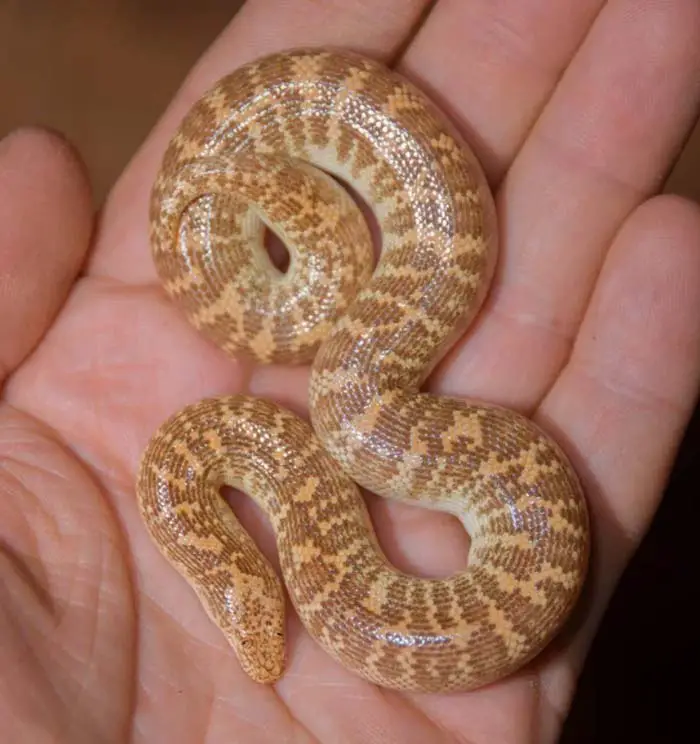
If you are nervous of an attack response when you go to pick up your snake for handling you can try hook training them.
To hook-train, you gently nudge the boa with your hook to alert them. If they do not shy away or burrow then you can go ahead and hook them out of the enclosure.
This will allow your boa to associate the hook with being handled and it will know what to expect. Hook training is not essential. However, if it makes you feel better then there is no harm.
If the snake is seriously stressed or feels threatened it will burrow and try to get away from you. Wait until it has calmed down before you attempt handling it.
Consistency is key to handling your Arabian Sand Boa. Make sure you handle it often and gently to help it get used to the feeling. A well-socialized Arabian Sand Boa will enjoy being handled.
We suggest handling your boa at least once a week for an hour.
Potential Health Issues
Before purchasing your Arabian Sand Boa, search for exotic pet veterinarians in your area. You know where to go for your own health emergencies. A snake that is this long-lived, needs the same connection to a vet.
Dermal abrasion: Arabian Sand Boas burrow and if the substrate is too rough it will damage their skin.
Respiratory issues and scale/mouth rot: These are caused by incorrect enclosure care. High humidity and incorrect substrate encourage bacterial growth which snakes are susceptible to.
External parasites: Mites are a common health issue for snakes. They will appear as tiny red or black dots on the snake’s skin, specifically around the nostrils, eyes, and mouth. They burrow under the scales to get at the snake’s blood. Mites carry their own diseases so getting rid of them is a top priority.
Internal parasites: These parasites could be from cross-contamination with other pets, from live food, or poor enclosure hygiene. Snakes may stop eating if they have a high parasite load. They will need an urgent trip to the vet.
Obesity: Arabian Sand Boas are good eaters and will eat food when offered. Therefore, they are prone to obesity when overeager owners do not stick to a feeding schedule. A fat snake is not a funny snake. Obesity can and will cause heart and liver failure.
Stuck Shed: After your snake has shed or come out of blue, check that their skin shed properly. If there are some bits that are stuck, line a plastic tub with warm wet paper towels and put your boa in for 30 minutes, then gently try to peel the stuck shed off with tweezers.
unlumm Feeding Tongs 15″ 2 Pcs
Breeding
Your Arabian Sand Boa does not need to undergo extensive brumation. You can cool their enclosure to 70°F on the cool side for the winter months. Match up the winter months to your winter months so that the temperature is easier to control.
Change their photocycle to 14 hours of dark and 10 hours of light.
You can continue to feed them throughout this time. At the end of the winter months (2 – 3 months), you can introduce your male to the female’s enclosure.
Leave them together for a week at a time. Remove the male to feed them both. Then return the male or cycle your males to spark interest and increase the chances of mating. Introduce the male during dusk or at night when they are most active.
You will notice a bump form on the female’s belly. She is now gravid (pregnant) and you can remove the male. She may or may not go off feed at this time so be prepared for both.
Provide her with a nesting box that is big enough for her to get into and turn around in.
After she gives birth you can remove the eggs or let her incubate them. They must be incubated at 91°F. So make sure the nesting box is under the basking spot. They will hatch after approximately 66 days.
Once the Arabian Sand Boa babies hatch, they can be put into their own enclosures of no less than 5 gallons. Once they have shed their skin, they can be offered their first pinky mouse.
Conclusion
Arabian Sand Boas are excellent pets for beginner snake owners. They are hardy animals that have a very simplistic enclosure set-up. They have simple care needs and are good eaters.
They are cool looking snakes that have unique evolutionary skills that have adapted them to a life of burrowing in the desert. This makes them very interesting snakes to watch while they move around their enclosures.
Make sure you have their set up done before you bring them home. If you are nervous about it, then ask your vet to pay a house call or get in touch with other people in the herp community.
We wish you the best of luck and ‘herp’ you have a successful journey with your new boa friend!
Related:

